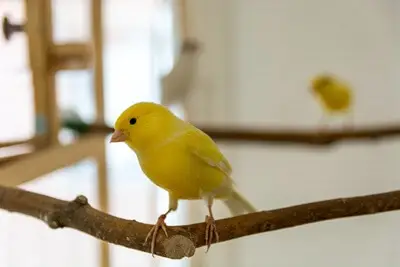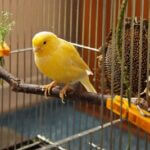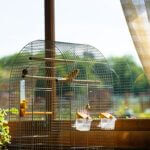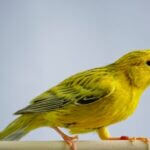Canaries’ feet, especially the soles and toes, are vulnerable to bacterial infection.
Bumblefoot, also known as ulcerative pododermatitis, is among the most common foot ailments. Canaries of all ages experience it, but aging and disabled birds are most vulnerable.
Abscesses, dark and circular scabs, thickened skin, inflammation, redness, lameness, and general unwellness are among the main signs and symptoms of bumblefoot.
If your canary finds walking or perching uncomfortable, it may have bumblefoot. If so, it’ll require treatment such as antibiotics to clear up the condition, as it rarely goes away on its own.
What Is Pododermatitis?
Bumblefoot is a foot infection caused by bacteria entering the body through an opening. According to Pitesky’s Poultry, the type of bacteria is usually staphylococcus, pseudomonas, or escherichia.
The bacteria enter the body through scrapes, cuts, punctures, grazes, and other open wounds, leading to a painful inflammatory response that makes movement and perching very difficult.
The causes of bumblefoot in pet canaries include:
- Hard, rough, and uneven surfaces
- Poorly designed perches
- Damp or unclean bedding
- Vitamin A deficiencies
- Fighting between cage mates
- Feces accumulation
- Overgrown claws
- Obesity
The most easily recognizable symptom of bumblefoot is swelling and redness. You may also observe ulcers, black or brown scabs, and thick skin on the base of one foot (most common) or feet.
Is Bumblefoot Contagious?
When one canary in a shared cage develops bumblefoot, it’s common for other birds in the enclosure to get infected. So, many owners erroneously assume that bumblefoot is a contagious condition.
One canary can’t get bumblefoot by coming into contact with an already-infected bird.
However, since bumblefoot results from bacterial infection and is most often caused by unhealthy living conditions, birds living in the same cage as an infected canary will be at a higher risk.
The best way to protect canaries from bumblefoot is to thoroughly clean the cage and eliminate any identified risks, such as abrasive perches and sharp-edged toys.
Exotic Animal Practice found that bumblefoot can affect rodents, rabbits, and birds. However, it’s not a zoonotic disease, so humans aren’t at risk of getting bumblefoot from birds.
Can Canaries Die of Bumblefoot?
It’s unusual for canaries to die due to contracting bumblefoot unless it’s ignored and left untreated.
Even then, it’s more likely that death will be caused by secondary issues related to bumblefoot, such as sepsis (an immune system overreaction) or malnutrition (due to not eating food).
It’s more likely that an untreated infection will lead to long-term health issues. So, your canary may live, but its quality of life will be significantly diminished.
For example, a severe infection left unresolved may require the consistent treatment of secondary issues for the remainder of the bird’s life.
In some cases, the infected foot may be too damaged to save. If so, foot amputation may be required.
Can Bumblefoot Heal on its Own?
By the time bumblefoot symptoms have developed, it’s unlikely that an infection will go away.
Regularly cleaning the infected area and soaking the foot in Epsom salts can sometimes draw out the infection and promote healing.
If you attempt this, you should cover the wound and any ulcers between cleaning and sanitizing the cage regularly to give your canary the best chance of healing and making a full recovery.
If you see no improvement in inflammation, swelling, or reduction in pus production, your canary will need treatment, such as prescribed antibiotics from a veterinarian.
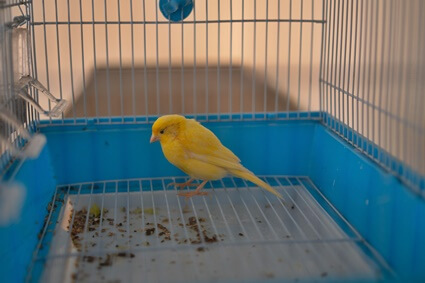
Can Bumblefoot be Cured?
In minor cases, the best treatment for bumblefoot is antibiotics to fight the infection. If the infection is too entrenched, surgical removal of part or all of the foot may be required.
While surgery is rarely the preferred option, it’s better than allowing an infection to continue with life-threatening consequences. If the vet suggests surgical removal as a part of the treatment for bumblefoot, it’ll always be the last resort.
Cleanliness is fundamental to avoiding the spread of the bacteria that cause bumblefoot. You can also lower the risk by avoiding perches with sharp/abrasive edges and improper perch sizing.
Treatment of Bumblefoot in Canaries
For a simple at-home treatment for bumblefoot, you can sanitize the infected area and soak the infected foot/feet in Epsom salts.
This may clear up any minor bacterial infections that aren’t too entrenched. A vet will use a sterile scalpel to remove the distinctive black scabs and infected flesh (if this doesn’t work).
Once the scabs are removed, a vet drains the pus, cleans the affected area, and covers the wound. You’ll need to ensure the cage is clean before returning the canary to its living space.
After doing so, antibiotics may be prescribed, such as::
- Amoxicillin
- Clavulanic acid
- Marbofloxacin
To effectively administer vet-prescribed antibiotics to a bird, you’ll need a firm but gentle grip of your canary, with your fingertips holding its head in place.
Take the syringe and slowly administer the prescribed amount. Administer the antibiotics slowly to ensure that your canary can swallow the fluid without experiencing any obvious discomfort.
Your vet will detail the antibiotics to be given and the frequency of administration. You should see a slight improvement in the skin’s condition within 1-3 days.
However, if this method of treatment is unsuccessful, or there are immediate concerns about the overall health of your canary, the vet may recommend surgical intervention.
This will be performed with a local or general anesthetic, depending on how extensive the surgery is, and it’ll take a few hours. A vet may inject 200 mg of oxytetracycline as a part of an aftercare plan.
Bumblefoot Aftercare
Proper aftercare is essential if your canary undergoes surgical treatment or receives antibiotics to treat bumblefoot. In non-surgical cases, this involves ensuring that:
- The cage is regularly spot cleaned daily and sterilized weekly.
- Your canary gets the right type and amount of antibacterial medication.
- Any open wounds are cleaned and covered for 7-10 days.
- New medication and sterile bandaging should be applied daily.
Aftercare will be more involved and prolonged if your canary undergoes surgical treatment for bumblefoot. The vet will explain how often to change bandages and clean the surgical wounds.
When preparing to remove old bandages and clean the infected wound, thoroughly wash your hands and the surface area you intend to use.
Ensure you hold the canary securely when removing the old dressing and cleaning the wound. Then, apply the prescribed cream/ointment and cover the area with a sterile bandage.
If your canary develops the symptoms of bumblefoot, you must take action to clear up the condition. Never wait for the condition to go away on its own, as it could have life-changing consequences.

